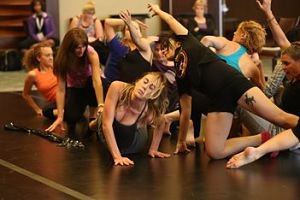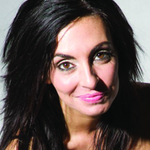
- GOALS/OBJECTIVES:
Using sensory awareness, current knowledge and descriptive writing about partners to communicate perception of them through movement phrasing. By performing this phrase for their partner, dancers will guess what is trying to be conveyed about them and whether or not their partner was correct in their perception. Dancers will learn to not only create phrases from their own creative writing and “biographies,” but also learn to communicate their thoughts through that movement while developing partnering skills. They will learn sensory awareness of others and whether perception is true (and often false) of people in their day to day life. Dancers will also inadvertently develop the idea of nuance in their portrayal of their partner’s personality and/or physical demeanor and get to know more about their partner/classmates.
- MATERIALS/MUSIC:
Music: Random, eclectic playlist from IPOD
3. INTRODUCTION/WARM-UP:
“Contradiction”-Pair up. Short, quick duet improvs that focus on time, energy space and quickly warm up the body. Break the duets/ and class into 2 groups:
(FOR TIME)- A’s are FAST-B’s are SLOW- GO. Switch.
When they are finished, they run quickly to another A or B partner!
(FOR ENERGY)- A’s are STRONG-B’s are GENTLE- GO. Switch.
(Again change partner)
(FOR SPACE)- A’s are Vertical-B’s are Horizontal. GO. Switch.
“Conversations”- Sit with partner and face them. Focus on them. Move when you would like to speak or have something to say. Partner may choose to respond to your movement and answer back through movement, gesture, facial expression, stillness, etc. Dancers may move at the same time but “listening” is also key to what they are trying to convey to you
- PRESENTATION OF PROBLEM/THEME: “BIOGRAPHIES”
Dancers sit with their partner. In their journals, they are to write 3-5 sentences on what they think they know about their partner. This could relate but is not limited to their personality, their backgrounds, their dance training, favorite ice-cream, etc. They may also choose to add a sentence of something they would like to know about them. Without sharing this information with their partner, they are then to develop a movement phrase trying to communicate those facts and/or questions which will be performed for their partners (Class will be broken up into the A’s going first and B’s observing their partners and then reverse). The partners will then try to ”decode” their biographies and discuss with their partner whether their perception of them was right or wrong.
- DEVELOPMENT/ELABORATION:
.Duet partners will then combine their phrases for theme development. They will then perform for the remaining observers who will try and decipher what they think the perceptions are and what characteristics belong to which partner.
.Combine phrases to join 2 sets of duets adding elements to the equation
(changing facings, start in canon, doing it as a “conversation ,etc.)
.Music will be an added element now and dancers will not know the selection chosen for
their groups.
- CULMINATION/SHARING/EVALUATION:
.Time to journal
. Discussion and group reflection on their thoughts of working so intimately with partners. Sharing ideas and discoveries on perceptions of others, trying to communicate through movement, “decoding” written word from movement, feelings on exercise, etc. What worked for you? What didn’t? What did you like about the exercise? What didn’t you like about the exercise? How did it affect you?
- ENDING THE SESSION:
.Partner massage and stretch.
.Relaxation and breathing exercise.
- NOTES:
.Important to take into account and be sensitive to the nature of the exercise and equip the students with the direction of such when instructing them to write the sentences about their partner perceptions. Encourage candidness but sensitivity to others as well. Remind students during the duet reflection as well as class discussion later on that they are not required to comment on anything they do not want to answer if it is too personal in nature.
.Important to vary the versatility of the music to add to the atmosphere. Incorporate everything from playful and comedic to serious and dramatic, etc. Important to take note of the energy shift and approach of movement quality and portrayal.
Good luck!
See you in the studio,
Jess

